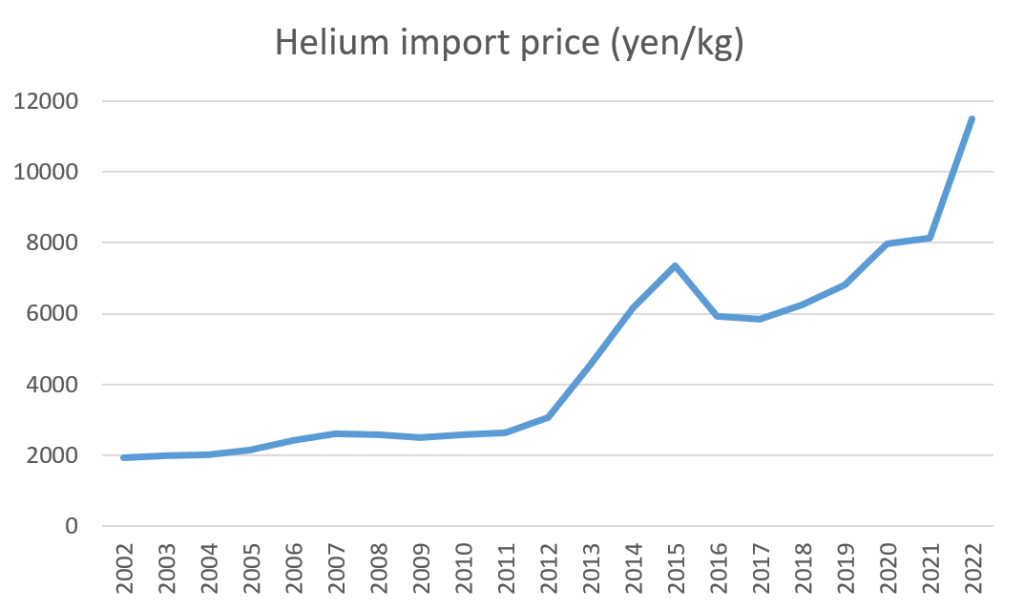Summary: Although SQUID sensors have been the only option for magnetoencephalography (MEG) for the past half-century, development of next-generation sensors is underway.
For the practical and commercial measurement of brain magnetic fields, SQUID (Superconducting Quantum Interference Device) sensors have been the only available option since 1972 [1], and this situation has continued for over half a century until the present (2023). However, magnetoencephalography (MEG) systems based on SQUID sensors have encountered at least three major challenges, making it difficult to operate in clinical settings.
- High running costs due to helium consumption.
- Inability to move the head during measurements because the sensors cannot be attached to the head.
- Requirement of a shielded room, necessitating a dedicated facility.
Problem 1 can be addressed commercially by using helium recycle systems, as helium import prices have surged over the years. For instance, according to the Trade Statistics of Japan, the import price of helium (Product code 280429100) has increased six-fold from 1,930 yen/kg in 2002 to 11,493 yen/kg in 2022 (Figure below).

As a reference, the Neuromag system used in the webmaster’s facility until March 2023 lacked the recycle system, resulting in the loss of 100 liters of liquid helium in one week. The boiling point of liquid helium at 1 atmosphere is -269 ℃, with a density of 0.125 kg/L. Furthermore, commercially available liquid helium has various additional costs.
Unable to cope with the soaring running costs, facilities conducting MEG systems are gradually withdrawing. It was estimated that there were around 10 functioning MEG facilities in Japan around 2020. Consequently, the number of cases covered by health care fees is declining, as indicated by the Ministry of Health, Labour and Welfare’s NDB open data (Figure below).

Thus, conventional MEG systems based on SQUID sensors require helium recycle systems. Currently, the TRIUX Neo system, which is operational in our institute as of June 2023, includes a helium recycle system, resulting in minimal helium loss. However, not all existing MEG systems are equipped with such systems, and the recovery rates may vary among systems.
Problem 1 and 2 can be addressed simultaneously by optical pumped magnetometers (OPMs) though under development [2].
NANOXEED (Tokyo) offers the QZFM Gen-3 optical pumped magnetometer module and a dedicated 64-channel head cap, stating their usage for “research purposes such as MEG and MCG (magnetocardiography).” Their capabilities are expected to be reported in the future.
During ISACM 2023 OSAKA (International Society for the Advancement of Clinical Magnetoencephalography) held in Osaka from May 24-27, 2023, booths showcasing OPM systems were set up. The exhibited systems included the HEDscan system (FiledLine, Physio-Tech), QZFM Gen-3 (Nanoxeed), and OPM-MEG system (Cerca, Quspin). According to one representative, although the sensors were magnetometers, they could be attached to the head, and they did not require helium. The price for each sensor was reportedly over one million yen. While these systems are not currently covered by health care fees in Japan, his plan was to seek FDA certification in the future. The representative expressed confidence in a lifespan of 10 years, but another company suggested it might be around one year. The actual performance can only be determined through practical operation.
Addressing Problems 1, 2, and 3 simultaneously, tunnel magneto-resistive (TMR) sensors show potential as a further developing solution [3]. The goal is to achieve a sensor array that can be attached to the head without the need for a shield room and can operate at room temperature.
Thus, a new generation of sensors is being developed to replace SQUIDs. However, it should be noted that as a historical fact, MEG were not of the kind that brought huge profits, and users are expected to wait patiently even if development is slow.
Summary: Next-generation sensors for MEG are currently in the development stage, and it is necessary to patiently await their availability.
Now that we have a general understanding of MEG sensor, in the next section we will discuss signal processing to isolate only the signal from the sensor output.
(References)
- Cohen D. Magnetoencephalography: detection of the brain’s electrical activity with a superconducting magnetometer. Science. 1972 Feb 11;175(4022):664-6.
- Boto E, Holmes N, Leggett J, Roberts G, Shah V, Meyer SS, Muñoz LD, Mullinger KJ, Tierney TM, Bestmann S, Barnes GR, Bowtell R, Brookes MJ. Moving magnetoencephalography towards real-world applications with a wearable system. Nature. 2018 Mar 29;555(7698):657-661.
- Kanno A, Nakasato N, Oogane M, Fujiwara K, Nakano T, Arimoto T, Matsuzaki H, Ando Y. Scalp attached tangential magnetoencephalography using tunnel magneto-resistive sensors. Sci Rep. 2022 Apr 12;12(1):6106.